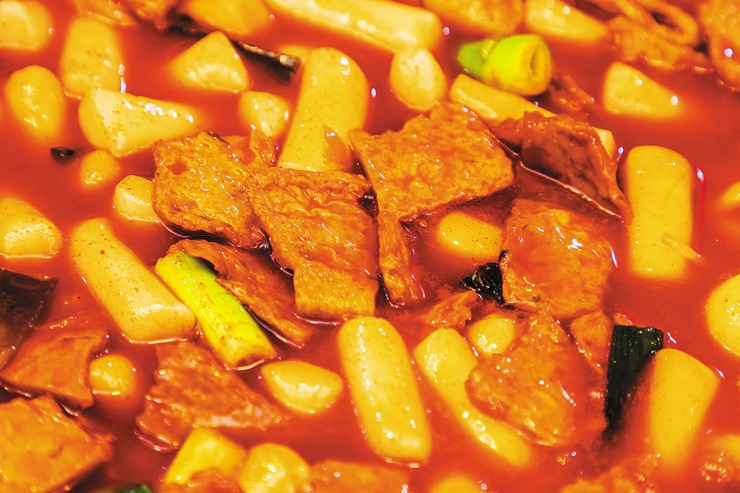Food
Stay warm with Korean soul food
During the chilly winter, Koreans keep warm with delectable street food called "bunsik." Bunsik, literally "food made with flour," encompasses a wide range of addictively flavored dishes, often served in large portions at low prices. Among them, the beloved "Winter Trio"-"eomuk," "twigim," and "tteokbokki"-hold a special place in the hearts of Koreans.

Eomuk, or fish cake, is served in a variety of shapes and flavors.
▣ Eomuk
Eomuk, or fish cake, is an iconic wintertime delicacy in Korea. Like fish cakes in other cultures, basic eomuk is a mixture of fish meat, vegetables and flour. The tasty and protein-rich snack originated in Busan in the 18th century by way of the Japanese fish cake known as kamaboko (the pink and white cakes found in bowls of ramen).
Unlike kamaboko, which is steamed, Korean eomuk is deep-fried. The resulting cake is served in a variety of forms, flavors and dishes. Eomuk skewered on long wooden sticks and warmed in a delicious broth is a common sight in food stalls nationwide.
While eomuk is eaten all over the peninsula, Busan eomuk is held in the highest regard since it features higher quality fish than those made in other regions. Furthermore, eomuk made here consists of a greater percentage of fish meat, reaching upwards of 70% compared to the conventional 50% to 60%. Some manufacturers even boast "high-grade" eomuk made of over 90% meat.


Tteokbokki(top) and twigim(bottom) are a match made in food heaven.
▣ Twigim
Twigim, meaning deep-fried in Korea, is another representative winter snack in Korea. It encompasses a variety of vegetables, proteins and starches dipped in batter and deep-fried. People enjoy the crispy texture and rich flavor.
"Gimmari twigim," deep-fried laver rolls, is a crispy and savory popular snack among Koreans. Glass noodles and chopped vegetables are wrapped in laver and deep-fried. Eaten as-is, dipped in seasoned soy sauce, or slathered in sweet and spicy tteokbokki sauce, gimmari twigim is a comfort food for all generations.
If you want a "healthier" deep-fried alternative, "gochu twigim" might be for you. The dish consists of Korean chili peppers stuffed with seasoned ground meat. The crunchy exterior, mild pepper taste and juicy meat is a winning combination.
▣ Tteokbokki
Kebab in Turkiye. Pad Thai in Thailand. Bahn mi in Vietnam. Every culture has a street food enjoyed by everyone, from toddlers to the elderly.
In Korea, that street food is tteokbokki. The dish of chewy rice cakes in sweet and spicy red sauce is the ultimate soul food, often enjoyed between classes or rounds of drinking.
If you need a conversation starter, ask a Korean if they prefer their tteokbokki made with "ssaltteok," made purely out of rice, or "miltteok," which look like rice cakes but are made with wheat flour. Some prefer miltteok because they are chewier and more deeply flavored.
Rice cakes come in many shapes, but for tteokbokki, the most common is cylindrical-shaped cakes called "garaetteok." Ssaltteok are short and thick, while miltteok are long and thin. Debates around tteokbokki can also be had around the gochujang-based sauce, with preferences over how sweet and spicy it is, and whether it is slathered like a BBQ sauce or more like a soup. Then, the discussion can center on toppings or mix-ins. Some prefer nothing, others just hardboiled eggs, and still others prefer a maximalist version with vegetables, eomuk and ramen noodles.
All of that can be discussed before even getting to "gungjung tteokbokki," or royal court rice cakes, a dish served to the monarchs of the Joseon Dynasty. Gungjung tteokbokki was created before the introduction of chili peppers to Korean cuisine, and features rice cakes, beef and vegetables stir-fried in a complex sauce of sesame oil, soy sauce and aromatics. Then, there are the Western-inspired takes, like carbonara tteokbokki and rose tteokbokki, which are creamier and cheesier.
▣ Must-visit street food locations
◎Darijip (다리집)
Darijip is one of the most famous tteokbokki joints in Busan. Back when it was a "pojangmacha," street food stall, only the legs of customers could be seen from the outside; hence it earned the name "House of Legs." They are especially known for huge portions of tteokbokki and fried squid - just one piece is enough to make you full.
-Address: No. 101, 70 Namcheonbada-ro 10beon-gil, Suyeong-gu
-Hours: Open 11:30 a.m. to 9 p.m. Closed on Tuesdays.
◎Lee Family's Tteokbokki (이가네 떡볶이)
Lee Family's Tteokbokki is well-known throughout Korea by appearing on famous TV shows. It is a must-visit stop when touring the original Busan city center, always bustling with customers.
-Address: 48 Bupyeong 1-gil, Jung-gu
-Hours: Open 10 a.m. to 5 p.m., or until everything is sold out. Closed on Sundays.

